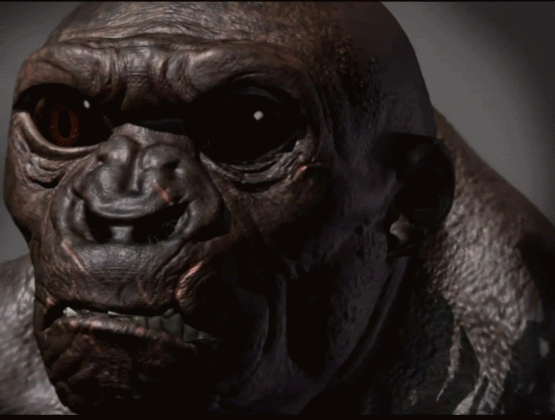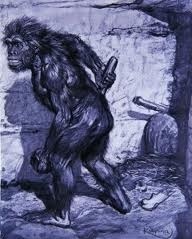
Posted on 03/11/2013 1:36:18 PM PDT by LibWhacker

A pair of newly discovered stars is the third-closest star system to the Sun, according to a paper that will be published in Astrophysical Journal Letters. The duo is the closest star system discovered since 1916. The discovery was made by Kevin Luhman, an associate professor of astronomy and astrophysics at Penn State University and a researcher in Penn State's Center for Exoplanets and Habitable Worlds.
Both stars in the new binary system are "brown dwarfs," which are stars that are too small in mass to ever become hot enough to ignite hydrogen fusion. As a result, they are very cool and dim, resembling a giant planet like Jupiter more than a bright star like the Sun. Image of WISE J104915.57-531906, taken by the WISE satellite.
"The distance to this brown dwarf pair is 6.5 light years -- so close that Earth's television transmissions from 2006 are now arriving there," Luhman said. "It will be an excellent hunting ground for planets because it is very close to Earth, which makes it a lot easier to see any planets orbiting either of the brown dwarfs." Since it is the third-closest star system, in the distant future it might be one of the first destinations for manned expeditions outside our solar system, Luhman said.
The star system is named "WISE J104915.57-531906" because it was discovered in a map of the entire sky obtained by the NASA-funded Wide-field Infrared Survey Explorer (WISE) satellite. It is only slightly farther away than the second-closest star, Barnard's star, which was discovered 6.0 light years from the Sun in 1916. The closest star system consists of Alpha Centauri, found to be a neighbor of the Sun in 1839 at 4.4 light years, and the fainter Proxima Centauri, discovered in 1917 at 4.2 light years.
Edward (Ned) Wright, the principal investigator for the WISE satellite, said "One major goal when proposing WISE was to find the closest stars to the Sun. WISE 1049-5319 is by far the closest star found to date using the WISE data, and the close-up views of this binary system we can get with big telescopes like Gemini and the future James Webb Space Telescope will tell us a lot about the low mass stars known as brown dwarfs." Wright is the David Saxon Presidential Chair in Physics and a professor of physics and astronomy at UCLA. Map showing distance of various stellar objects from sun, in light years.
Astronomers have long speculated about the possible presence of a distant, dim object orbiting the Sun, which is sometimes called Nemesis. However, Luhman has concluded, "we can rule out that the new brown dwarf system is such an object because it is moving across the sky much too fast to be in orbit around the Sun."
To discover the new star system, Luhman studied the images of the sky that the WISE satellite had obtained during a 13-month period ending in 2011. During its mission, WISE observed each point in the sky 2 to 3 times. "In these time-lapse images, I was able to tell that this system was moving very quickly across the sky -- which was a big clue that it was probably very close to our solar system," Luhman said.
After noticing its rapid motion in the WISE images, Luhman went hunting for detections of the suspected nearby star in older sky surveys. He found that it indeed was detected in images spanning from 1978 to 1999 from the Digitized Sky Survey, the Two Micron All-Sky Survey, and the Deep Near Infrared Survey of the Southern Sky. "Based on how this star system was moving in the images from the WISE survey, I was able to extrapolate back in time to predict where it should have been located in the older surveys and, sure enough, it was there," Luhman said.
By combining the detections of the star system from the various surveys, Luhman was able to measure its distance via parallax, which is the apparent shift of a star in the sky due to the Earth's orbit around the Sun. He then used the Gemini South telescope on Cerro Pachón in Chile to obtain a spectrum of it, which demonstrated that it had a very cool temperature, and hence was a brown dwarf. "As an unexpected bonus, the sharp images from Gemini also revealed that the object actually was not just one but a pair of brown dwarfs orbiting each other," Luhman said.
"It was a lot of detective work," Luhman said. "There are billions of infrared points of light across the sky, and the mystery is which one -- if any of them -- could be a star that is very close to our solar system."
If there were inhabited planets in orbit around brown dwarfs, it seems most likely to me they'd be Europa-type planets with life possibly existing in oceans under thick ice layers, not places for us!
I have no idea who the guy is, but he has a great face and aspect. First used him on a Gurkha thread...
It would necessarily need oceans, and it would probably have a fair amount of vulcanism. It would also need to be much closer to its ‘sun’ to get its radiated heat to keep it from freezing, say at the orbit of Mercury, and a nitrogen/oxygen atmosphere with a mass near that of Earth’s.
Its ‘sun’ would block out most of the sky during the ‘day’ and just be a big, velvety black spot to us, but to ‘them’ it would be a blazing inferno, just as Sol appears to us, because of their sensitivity in the infra-red region of the spectrum.
Green plants would be practically non-existent, except as scientific curiosities. Fungal growth would be like forests, with mushrooms the size of redwoods. Grasslands would be replaced by carpets of fungal communities and small bush sized fungal growths.
Animals would have evolved more slowly, but still they would differentiate into fungi-eaters and meat-eaters to preserve the predator-prey balance.
A dark world , to be sure, but colors would still be found in the flora and fauna simply due to natural selection and the need for camouflage, like we have fishes of very bright colors but they cannot see the colors due to the sunlight filtering of the water.
Imagine a sentient species evolving that would be able to ‘see’ in infrared. They would have very large ‘eyes’ that would gather as much ‘light’ as is possible, just like our night creatures that have large eyes for night time hunting as well as for protection from predators. Kinda sounds like the ubiquitous space alien caricature with the small heads and over sized teardrop shaped eyes.........
Venramini's Neanderthal reconstruction, the first thing you notice is the huge eyes (Neanderthal eye sockets 2+ times the size of ours):

Image courtesy www.themandus.org, Ice-Age fur coat removed for illustration purposes...
And the reason why we should pay attention to the theories of Danny Vendramini, a TV producer and scriptwriter with no academic credentials, is?
Gee, Grandma, what big eyes you have!..........


Red Dwarf star, much closer than 4.5 light years..........
The reason is, that Vendramini has figured out what Neanderthals actually looked like, and all of the “brilliant scientists(TM)” who’ve studied the fricking things for the past 150 years, haven’t. Granted Vendramini’s theory of Neanderthal predation driving gracile (Skhul/Qafzeh) hominids to punc-eek their way into modern men is BS, his reconstruction of the Neanderthal is totally believable.
Name the first one "John" and the other "Lyndsey".
No, Vendramini has come out with an alternate theory for what Neanderthals actually looked like. Nobody has seen an actual Neanderthal in the flesh.
Forensic reconstruction of faces from skulls is an established field. People who do it for a living have lots of feedback based on later determination of who it was who belonged to the skull. I trust their determinations more than I trust Vendramini.

Neanderthal footprint(real, not artist conception):

Next time it rains, find some mud and see if you can make a footprint like that.
Neanderthal and human skeletons:
Note the cylindrical human ribcage and the conical Neanderthal rib cage. The conical primate rib cage simply allows room for the gigantic primate upper-body musculature.
Homo Erectus ("Turkana Boy") skeleton and reconstruction (Wikipedia), note the conical rib cage and also note that other than for the smooth skin which is wrong, scientists don't have any problem presenting Erectus (a close cousin of the Neanderthal) as a glorified ape which is in fact what both of them were:

The Neanderthal is generally presented as a slightly backwards or Down-Syndrome-like human because he has become a sort of a poster child for kum-bay-ah religion and scientific yuppyism. Representations from the late 1800s and early 1900s (i.e. from prior to the yuppifaction of science) looked much more like Vendramini's, e.g. Pierre Boule's reconstruction:

This is a case of the scholars from 1900 having it right or nearly right, and of more modern researchers having gone astray.
Aside from everything else, there's the question of no Neanderthal needles having ever been found (Cro Magnon needles are common); basic reality is that a creature with a 6" Ice-Age fur coat doesn't NEED needles...
Disclaimer: Opinions posted on Free Republic are those of the individual posters and do not necessarily represent the opinion of Free Republic or its management. All materials posted herein are protected by copyright law and the exemption for fair use of copyrighted works.